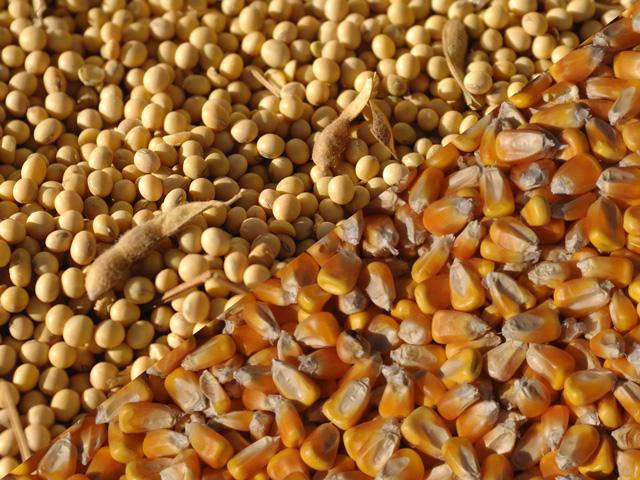Insurance Guarantees Highest in Years
Spring Crop Insurance Guarantees Set at $4.58 for Corn, $11.87 for Soybeans
MT. JULIET, Tenn. (DTN) -- Spring crop insurance guarantees for corn and soybeans will be $4.58 and $11.87 per bushel, respectively, increases of $0.70 and $2.70 from last year.
For corn, it's the highest spring guarantee since 2014; it's the highest since 2013 for soybeans.
The guarantees are an integral part of revenue protection crop insurance policies. While farmers have several types of federally subsidized crop insurance to choose from, revenue protection is the most popular. The spring guaranteed prices are calculated by averaging the daily close of the December corn and November soybean contracts throughout February. They're then combined with the farm's historical yield average to calculate a level of insurable revenue. Farmers can elect to cover up to 85%, with most farmers choosing to purchase 75%, 80% or 85%, depending on what the premiums are in their area.
Higher guarantees, like this year, mean farmers will have better protection if prices or yields dropped sharply. If a farmer purchases 85% coverage on corn, that equates to a price of $3.89 per bushel, at or above many farmers' break-even levels.
"I think, No. 1, is that it helps farmers relax a little bit knowing that they've got pretty good downside protection there and can still come out OK if, for some reason, prices did fall apart and go lower," DTN Lead Analyst Todd Hultman said.
P[L1] D[0x0] M[300x250] OOP[F] ADUNIT[] T[]
For most Midwestern growers, the deadline to purchase crop insurance is March 15. University of Illinois ag economist Gary Schnitkey said farmers should expect premiums to increase. He also encourages farmers to consider a new supplemental crop insurance product, called the Enhanced Coverage Option. While it's based on county yields instead of farm history, it has a high probability of paying out. For more details on that program, please read "New Crop Insurance Option Provides Higher Levels of Coverage" here: https://www.dtnpf.com/….
Higher crop insurance guarantees reflect the upward trend in prices that began last August, as Chinese demand for corn and soybean picked up speed.
"I think there's a lot of bullishness in the country right now," Hultman said. "Even after USDA's new-crop estimates at the Ag Forum, there's not a big expectation prices are going to fall apart this year. So I think that those kinds of worries are -- I won't say totally off the table -- but I think, in the minds of many, certainly are much less this year, and the crop insurance just helps add to that peace of mind."
USDA released its first look at new-crop supply and demand estimates last week. It estimates farmers will plant 92 million acres of corn and 90 million acres of soybeans. But, despite high production forecasts, early ending stocks estimates for both crops are tighter, at 1.6 billion bushels for corn and 145 million bushels for soybeans. For more on USDA's early outlook, please read "Outlook Forecasts Larger Corn, Soybean Crops for 2021" here: https://www.dtnpf.com/….
Hultman said the higher guarantees give farmers even more incentive -- on top of spot prices of $5 per bushel for corn and $13 for soybeans -- to plant as many acres as they can.
"I've heard some say that, if the weather is dry early and things look favorable the way it's looking right now, they might just keep planting their corn once they get going," Hultman said. "But, on the other hand, some are saying that fertilizer for corn might be getting a little more expensive or difficult to come by and that with possibly a dry weather outlook might tilt some more people to soybeans. I'm really hoping we come out close to a 50-50 split this year, but we'll be crossing our fingers to see how that works out."
Retail fertilizer prices have jumped significantly over the past several months, and especially in the last few weeks, according to prices gathered by DTN. While DAP and MAP prices have generally led the charge, prices for nitrogen products are also surging, with urea prices increasing 18% from the month before. UAN32 gained 15% while UAN28 jumped 14%. Anhydrous ammonia prices, currently at $530 per ton, are also 10% higher than the month before. For more on recent price moves, please read "Fertilizer Price Rally Continues; DAP, Urea, UAN Prices Surge" here: https://www.dtnpf.com/….
Hultman said the strength of corn and soybean prices could draw more acres away from spring wheat, even though spring wheat price guarantees at $6.53 per bushel are almost $1 per acre higher than last year. "The nice thing is that, for the most part, wheat's kind of going along with corn and beans."
USDA will begin surveying farmers on their planting intentions next week and will release their finding in the March 31 Prospective Plantings report.
Katie Dehlinger can be reached at katie.dehlinger@dtn.com
You can follow her on Twitter @KatieD_DTN
(c) Copyright 2021 DTN, LLC. All rights reserved.




